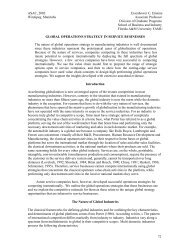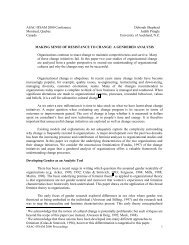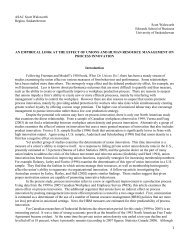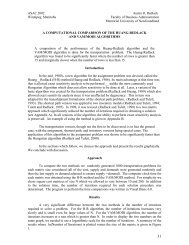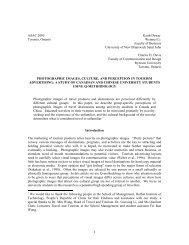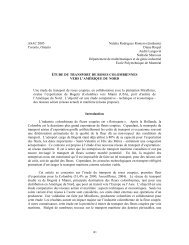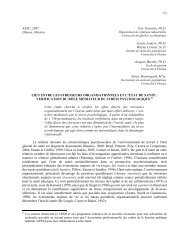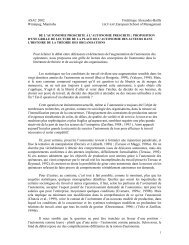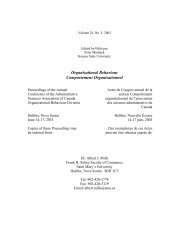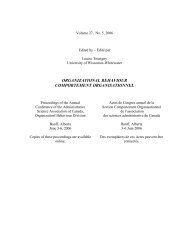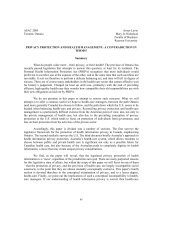distortion in information systems project status reporting
distortion in information systems project status reporting
distortion in information systems project status reporting
Create successful ePaper yourself
Turn your PDF publications into a flip-book with our unique Google optimized e-Paper software.
ASAC 2005Toronto, OntarioRon ThompsonCharles IacovouH. Jeff SmithBabcock Graduate School of ManagementWake Forest UniversityDISTORTION IN INFORMATION SYSTEMS PROJECT STATUS REPORTINGPrevious research has shown that <strong>in</strong>formation <strong>systems</strong> (IS) <strong>project</strong>s are prone todistorted report<strong>in</strong>g, which can have an adverse effect on performance. We derivea conceptual model of salient factors that contribute to <strong>in</strong>accurate report<strong>in</strong>g, andtest it us<strong>in</strong>g responses from 191 team members work<strong>in</strong>g on numerous IS <strong>project</strong>swith<strong>in</strong> governmental agencies.IntroductionTo address perceived deficiencies <strong>in</strong> IS <strong>project</strong> management, there has been considerableresearch <strong>in</strong>to factors that impede or facilitate IS <strong>project</strong> success. Many have focused on issuessuch as risk components (Ropponen, 1999), <strong>project</strong> management (Nidumolu, 1995), and user<strong>in</strong>volvement and senior management support (McKeen and Guimaraes, 1997). Only recently hasanother factor begun to receive attention: communication regard<strong>in</strong>g <strong>project</strong> <strong>status</strong> <strong>in</strong>formationwith<strong>in</strong> the organizational hierarchy.Previous research suggests that distorted IS report<strong>in</strong>g is pervasive <strong>in</strong> IS development andis detrimental to the <strong>project</strong>s’ success (Keil and Robey, 2001; Smith and Keil, 2003). Accord<strong>in</strong>gto this l<strong>in</strong>e of research, <strong>in</strong>dividuals report<strong>in</strong>g on the <strong>status</strong> of IS <strong>project</strong>s frequently provide<strong>in</strong>accurate representations, especially when they must deliver bad news about the <strong>project</strong>(Iacovou, 1999; Keil and Robey, 2001; Smith and Keil, 2003). Furthermore, it has been positedthat <strong>in</strong>accurate report<strong>in</strong>g <strong>in</strong> turn has a damag<strong>in</strong>g impact on the performance of IS <strong>project</strong>s (Keiland Robey, 2001; Tan et al., 2003).The objective of this study is to develop and test a model l<strong>in</strong>k<strong>in</strong>g 1) factors hypothesizedto <strong>in</strong>fluence the quality of <strong>project</strong> report<strong>in</strong>g, and 2) the impact of report<strong>in</strong>g quality on <strong>project</strong>performance. To the best of our knowledge, this represents the first attempt to do so. Therema<strong>in</strong>der of the paper is structured as follows. First, we review relevant literature to explorepotential causes of <strong>distortion</strong> <strong>in</strong> IS <strong>project</strong> report<strong>in</strong>g. Next, we present our research model andassociated hypotheses. Follow<strong>in</strong>g that, we describe our research methodology and our results.The paper concludes with a discussion of contributions of the work and opportunities for futureresearch.72
Distortion <strong>in</strong> IS Project Status Report<strong>in</strong>gIS <strong>project</strong> report<strong>in</strong>g refers to the upward communication (either verbal or written) of<strong>in</strong>formation about the <strong>status</strong> of <strong>project</strong> activities to <strong>in</strong>terested managers. In such communications,the reporters usually compare the state of the activities for which they are responsible (withrespect to budgets, schedules and other dimensions) aga<strong>in</strong>st a <strong>project</strong> plan and identify issues thatmay be caus<strong>in</strong>g deviations from the plan. Our work primarily focuses on the “team-member tothe <strong>project</strong> manager” communication l<strong>in</strong>k of the <strong>project</strong> communication cha<strong>in</strong>, because of thecritical role it plays <strong>in</strong> manag<strong>in</strong>g the <strong>project</strong>. S<strong>in</strong>ce team members are the orig<strong>in</strong>al sources of key<strong>status</strong> <strong>in</strong>formation, and <strong>project</strong> managers tend to be the key decision-makers <strong>in</strong> runn<strong>in</strong>g the<strong>project</strong> activities, communication <strong>in</strong> this dyad is likely to have an <strong>in</strong>fluence on <strong>project</strong>performance.In addition to the <strong>in</strong>herent difficulties associated with assess<strong>in</strong>g <strong>project</strong> <strong>status</strong> (e.g.,<strong>project</strong> size and complexity, subjective nature of assess<strong>in</strong>g the <strong>project</strong> development process, etc.),certa<strong>in</strong> behaviours by report senders further degrade the quality of report<strong>in</strong>g <strong>in</strong> IS <strong>project</strong>s.Research shows that report<strong>in</strong>g quality also suffers because report senders are not always will<strong>in</strong>gto provide accurate and complete <strong>in</strong>formation about the <strong>status</strong> of their <strong>project</strong> work (Snow andKeil, 2002).To understand what motivates reporters to deliberately distort their reports, we turn to theMessage Exchange literature. Accord<strong>in</strong>g to this perspective, reports are viewed as <strong>in</strong>strumentsthat enable reporters to engage <strong>in</strong> selective fact encod<strong>in</strong>g and biased <strong>in</strong>formation-giv<strong>in</strong>g <strong>in</strong> orderto pursue their goals (Stohl and Redd<strong>in</strong>g, 1987). In such communications, IS <strong>project</strong> reporters arelikely to distort their reports to enhance their professional image, deflect blame for <strong>project</strong>problems, please powerful supervisors, or further other personal goals (Athanassiades, 1973).Message Exchange researchers have identified and empirically assessed severalantecedents of <strong>distortion</strong>, <strong>in</strong>clud<strong>in</strong>g attributes of the relationship between the reporter and theexecutive (Fulk and Mani, 1986). Our research model (see Figure 1) <strong>in</strong>corporates thesepreviously <strong>in</strong>vestigated dyadic factors to provide a new perspective on IS report<strong>in</strong>g. Moreover, itextends the exist<strong>in</strong>g Message Exchange literature <strong>in</strong> two ways. First, we supplement pastresearch on distorted report<strong>in</strong>g by <strong>in</strong>troduc<strong>in</strong>g additional dyadic and <strong>project</strong>-level factors that aresalient <strong>in</strong> IS development. These factors <strong>in</strong>clude the (1) organizational membership of thereport<strong>in</strong>g dyad, (2) the <strong>project</strong>’s perceived importance, (3) the <strong>project</strong>’s structure and (4) thecontrols employed <strong>in</strong> the <strong>project</strong>. These factors were identified based on our review of the ISliterature on <strong>project</strong> communication and management. Second, we extend our model beyond thequality of report<strong>in</strong>g to also <strong>in</strong>clude the impact of report<strong>in</strong>g quality on <strong>project</strong> performance.In the follow<strong>in</strong>g sections, we discuss each of the <strong>distortion</strong> antecedents <strong>in</strong> detail. To limitthe complexity of our model, we treat the above antecedent factors as be<strong>in</strong>g <strong>in</strong>dependent; that is,we do not explicitly address the possibility of <strong>in</strong>teractions among the antecedent factors, or ofmoderat<strong>in</strong>g <strong>in</strong>fluences that might occur. That level of analysis is left for future research.73
Figure 1Research ModelPM*Power+-DyadMembershipPM*TrustProjectImportanceProjectUncerta<strong>in</strong>tyProjectControl-++-+Distortion <strong>in</strong>Communications-Report<strong>in</strong>gQuality+ProjectPerformance* PM = Project ManagerTrust <strong>in</strong> Project Executive: Trust is “behavioral reliance on another person under acondition of risk” (Currall and Judge, 1995). A lack of trust will create concerns about thepotential misuse of transmitted <strong>in</strong>formation by <strong>project</strong> executives (aga<strong>in</strong>st the <strong>in</strong>terests ofreporters). Because of this, concerned reporters would be more selective and guarded with their<strong>project</strong> reports when deal<strong>in</strong>g with untrustworthy executives. Empirical evidence supports therelationship between trust and <strong>distortion</strong> (O’Reilly and Roberts, 1974; Fulk and Mani, 1986).Consequently, we posit that:Hypothesis 1: Reporters with high trust <strong>in</strong> their <strong>project</strong> managers will distort their ISreports less than those with low trust.Project Executive’s Power: Power refers to the level of <strong>in</strong>fluence that a <strong>project</strong>executive has over the reporter. This “power distance” between the two is usually determ<strong>in</strong>ed bythe relative positions of the reporter and the <strong>project</strong> executive <strong>in</strong> the organizational hierarchy andthe level of upward <strong>in</strong>fluence that the executive can exert with<strong>in</strong> the organization (Fulk and Mani,1986; Stohl and Redd<strong>in</strong>g, 1987). Reporters who are <strong>in</strong> low power positions (relative to theexecutives) are more likely to slant their reports, especially when transmitt<strong>in</strong>g <strong>in</strong>formation that is74
detrimental to their own <strong>in</strong>terests or that conta<strong>in</strong>s bad news (Fulk and Mani, 1986; Stohl andRedd<strong>in</strong>g, 1987; Bean, 2001). Given the evidence support<strong>in</strong>g the l<strong>in</strong>kage between power and<strong>distortion</strong>, we propose that:Hypothesis 2: Reporters communicat<strong>in</strong>g to more powerful executives will distort their ISreports more than those communicat<strong>in</strong>g to less powerful ones.Organizational Membership: Homogenous dyads <strong>in</strong>clude a report sender and receiverwho are both employed by the same departrment, while <strong>in</strong> a heterogenous one they are <strong>in</strong>different departments (or firms). The dyad’s membership is likely to affect <strong>distortion</strong> <strong>in</strong> twoways. First, because of <strong>in</strong>ter-cultural communication issues that are present <strong>in</strong> heterogeneousdyads, communication is likely to be less effective. Indeed, research shows that functionallydiverse teams (i.e., those <strong>in</strong>clud<strong>in</strong>g <strong>in</strong>dividuals from multiple departments) are likely toexperience lower quality <strong>in</strong>teractions due to different communication styles and the <strong>in</strong>herenttension and power struggles <strong>in</strong> multi-group sett<strong>in</strong>gs (Oetzel, 2001). Such communicationenvironments are likely to have an enhanc<strong>in</strong>g effect on face-sav<strong>in</strong>g tactics, <strong>in</strong>clud<strong>in</strong>g <strong>distortion</strong>.Thus, the work on diverse <strong>project</strong> teams suggests that:Hypothesis 3: Reporters <strong>in</strong> heterogeneous dyads will distort their IS reports morefrequently than those <strong>in</strong> homogeneous dyads.Second, we assert that organizational membership is likely to impact <strong>distortion</strong> <strong>in</strong>directlyby affect<strong>in</strong>g the level of the <strong>project</strong> executive’s power. One would expect that the relative powerof the <strong>project</strong> executive over the <strong>project</strong> participant would be lower <strong>in</strong> dyads with heterogeneousorganizational membership than <strong>in</strong> those with homogeneous organizational membership. Thus,heterogeneous membership could be expected to have a suppress<strong>in</strong>g effect on <strong>distortion</strong>,mediated through the <strong>project</strong> executive’s power. We expect that:Hypothesis 4: Reporters <strong>in</strong> homogeneous dyads will perceive their executives to be morepowerful than those <strong>in</strong> heterogeneous dyads.Based on our review of the IS <strong>project</strong> management literature, we identified three <strong>project</strong>factors that are likely to be significant <strong>in</strong> terms of their <strong>in</strong>fluence on <strong>distortion</strong> <strong>in</strong> <strong>project</strong>report<strong>in</strong>g. These salient factors are: perceived <strong>project</strong> importance (Barki et al., 2001), <strong>project</strong>structure (McFarlan, 1981) and <strong>project</strong> control management (Henderson and Lee, 1992).Project Importance: Importance refers to the significance that the organization placeson the system under development. It is determ<strong>in</strong>ed by the strategic potential and by the symbolicvalue of the system (Iacovou, 1999), and it is likely to <strong>in</strong>fluence <strong>distortion</strong>. Specifically, strategicIS <strong>project</strong>s tend to be large, complex undertak<strong>in</strong>gs, consum<strong>in</strong>g significant f<strong>in</strong>ancial and humanresources (Ewusi-Mensah and Przasnyski, 1991; Iacovou, 1999). Given the large volume andcomplexity of sub-tasks that must be monitored, ambiguity is likely to <strong>in</strong>crease, with moreopportunities for undetected <strong>distortion</strong>. Consistent with the above assertions, Bean (2001) foundempirical support for the relationship between <strong>project</strong> importance and <strong>distortion</strong>. Thus, weanticipate that:75
Hypothesis 5: Reporters <strong>in</strong> high importance <strong>project</strong>s will distort their IS reports morethan those <strong>in</strong> low importance ones.Project Structure: Project structure refers to level of ambiguity <strong>in</strong> the specifications ofthe desired <strong>project</strong> deliverables (McFarlan, 1981; Nidumolu, 1995). Low structure <strong>project</strong>ssuffer from a lack of clarity and specificity <strong>in</strong> the system requirements and frequent changes tothem over the course of the <strong>project</strong>; high structure <strong>project</strong>s, on the other hand, have clearer andmore stable requirements (Nidumolu, 1995). Distortion is more likely to occur <strong>in</strong> low structure<strong>project</strong>s because uncerta<strong>in</strong>ty and ambiguity makes it more difficult for executives to detect it,which <strong>in</strong> turn makes it a less risky behaviour. We assert that:Hypothesis 6: Reporters <strong>in</strong> low structure <strong>project</strong>s will distort their IS reports more thanthose <strong>in</strong> high structure <strong>project</strong>s.Project Control Management: Project control refers to “the set of mechanisms designedto motivate <strong>in</strong>dividuals to work <strong>in</strong> such a way that desired objectives are achieved” (Kirsch et al.,2002, p. 485). The <strong>in</strong>troduction of structured controls <strong>in</strong> a <strong>project</strong> (e.g., specific methodologies,design approaches, CASE tools) is likely to decrease the <strong>in</strong>cidents of <strong>distortion</strong> as it will maketheir potential detection more likely. P<strong>in</strong>to and Mantel’s (1990) f<strong>in</strong>d<strong>in</strong>gs lend support to thisargument. They found that the use of schedules, plans, and other control mechanisms wasassociated with better communication and improved trouble-shoot<strong>in</strong>g. Research show<strong>in</strong>g that theuse of control tools <strong>in</strong> IS <strong>project</strong>s positively impacts their performance (Henderson and Lee,1992; Barki et al., 2001) is also consistent with this assertion. We therefore propose that:Hypothesis 7: Reporters <strong>in</strong> <strong>project</strong>s with strong <strong>project</strong> controls will distort their ISreports less than those <strong>in</strong> <strong>project</strong>s with lax controls.As <strong>in</strong>dicated <strong>in</strong> the <strong>in</strong>troduction, numerous researchers have posited that <strong>in</strong>creased<strong>distortion</strong> <strong>in</strong> communications will lead to lower quality <strong>project</strong> report<strong>in</strong>g. With this l<strong>in</strong>e ofresearch, <strong>in</strong>dividuals report<strong>in</strong>g on the <strong>status</strong> of IS <strong>project</strong>s frequently provide <strong>in</strong>accuraterepresentations, especially when they have to deliver bad news about the <strong>project</strong> (Iacovou, 1999;Keil and Robey, 2001; Smith and Keil, 2003). As a result, we anticipate that:Hypothesis 8: Higher levels of <strong>distortion</strong> will be associated with lower <strong>project</strong> report<strong>in</strong>gquality.S<strong>in</strong>ce IS <strong>project</strong>s are social undertak<strong>in</strong>gs that aim to develop a technological system foran organization, assess<strong>in</strong>g their performance can be a complex task. From a social perspective,one would expect that successful <strong>project</strong>s would result <strong>in</strong> satisfied <strong>project</strong> members; from atechnological perspective, they should produce usable <strong>systems</strong> <strong>in</strong> an efficient manner; and froman organizational perspective, they should result <strong>in</strong> a net benefit to the adopt<strong>in</strong>g firm (Aladwani,2002). Although, to the best of our knowledge the impact of report<strong>in</strong>g quality on <strong>project</strong>performance has not been tested formally, we posit that:76
Hypothesis 9: Higher quality report<strong>in</strong>g will be associated with stronger <strong>project</strong>performance (<strong>in</strong>clud<strong>in</strong>g task, psychological and organizational outcomes).One additional factor was added to our model as a control factor (for analysis purposes).Related to the issue of <strong>project</strong> structure, we believe that the size and complexity of a <strong>project</strong> couldhave an impact on <strong>distortion</strong> behaviors by <strong>project</strong> members. More specifically, <strong>in</strong> larger, morecomplex <strong>project</strong>s, it will be more difficult for a <strong>project</strong> manager to detect <strong>distortion</strong>s <strong>in</strong>communications, and hence we may anticipate more <strong>distortion</strong> would occur. For that reason, weadded <strong>project</strong> size to our model as a control variable.SampleThe sample consisted of <strong>in</strong>dividuals who were team members <strong>in</strong> state governmental<strong>project</strong>s <strong>in</strong> an Eastern U.S. state. These <strong>in</strong>dividuals <strong>in</strong>cluded users, IS professionals and vendorrepresentatives. We used stratified sampl<strong>in</strong>g to select a diverse subset of <strong>project</strong>s (based onseveral dimensions, <strong>in</strong>clud<strong>in</strong>g <strong>project</strong> duration, budget, and vendor <strong>in</strong>volvement) from a list<strong>in</strong>g ofon-go<strong>in</strong>g state <strong>project</strong>s. Surveys were sent to all non-executive participants <strong>in</strong> each selected<strong>project</strong>. The cover letter that accompanied the survey was signed by the researchers, the stateauditor and an executive from each respondent’s organization. The respondents were <strong>in</strong>structedto answer the questions <strong>in</strong> the questionnaire with<strong>in</strong> the context of a specific IS <strong>project</strong> (the <strong>project</strong>on which the participant spent most of his/her time).Five hundred surveys were mailed, and twenty-one were returned as undeliverable. Tworem<strong>in</strong>ders (one ten days after the survey mail<strong>in</strong>g and the other two weeks later) were emailed toeach subject. Two hundred and sixty-four participants responded, yield<strong>in</strong>g a gross response rateof 55.1%. Of these, seventy-three cases were removed from the sample because of miss<strong>in</strong>g data.A case was removed if the respondent did not complete two or more of the items for anyconstruct. In addition, a case was removed if the respondent had not answered the s<strong>in</strong>gle item for“organizational outcome.” This left one hundred and n<strong>in</strong>ety-one usable responses, for a netresponse rate of 43.8%.Test of MeasuresWherever possible, we utilized previously developed and validated perceptual measuresto assess the constructs of <strong>in</strong>terest (see Appendix 1 for a list of the measures). To assess thequality of report<strong>in</strong>g (from the <strong>project</strong> team members to the <strong>project</strong> manager), we utilized Mohrand Spekman (1994)’s communication quality scale. This measure assesses the follow<strong>in</strong>g fivedimensions of report<strong>in</strong>g quality: timel<strong>in</strong>ess, accuracy, adequacy, completeness and credibility.The items used to measure <strong>distortion</strong> behaviors were developed specifically for thisstudy. The six items were based loosely on measures orig<strong>in</strong>ally employed by Roberts andO’Reilly (1974). The development process <strong>in</strong>cluded a card-sort<strong>in</strong>g exercise with six participants.Follow<strong>in</strong>g the card-sort<strong>in</strong>g exercise, modifications were made to the word<strong>in</strong>g of three items toaddress potential weaknesses that had been identified.77
At the <strong>project</strong> level, <strong>project</strong> importance was captured through eight items taken from the11-item scale developed by Barki et al. (2001). We removed three items that did not appearrelevant to the public-sector context of our study. Project uncerta<strong>in</strong>ty was measured with a fouritem scale employed by Nidumolu (1995). The six items used to measure <strong>project</strong> control weretaken from Barki et al. (2001).The three measures for trust <strong>in</strong> the <strong>project</strong> executive, as well as the three items measur<strong>in</strong>gpower of the <strong>project</strong> executive, were taken from Roberts and O’Reilly (1974). We also <strong>in</strong>cludeda s<strong>in</strong>gle item to determ<strong>in</strong>e whether or not the <strong>project</strong> manager and the <strong>project</strong> executive wereemployed by the same organization (i.e., dyad membership).To analyze the data, we utilized the Partial Least Squares (PLS) technique; morespecifically, the PLS-Graph version 3.0 software was used to carry out the analysis (Ch<strong>in</strong> andFrye, 2001). All constructs were measured with multiple reflective <strong>in</strong>dicators, with the exceptionof <strong>project</strong> performance. To evaluate <strong>project</strong> performance, we used an 11-item, multi-dimensionalscale that was developed by Aladwani (2002). S<strong>in</strong>ce we have conceptualized <strong>project</strong>performance as a higher-order construct that has three separate dimensions, it was appropriate tomodel performance with formative <strong>in</strong>dicators. To do so, we computed a summed score for eachof task outcomes (7 <strong>in</strong>dicators) and psychological outcomes (3 <strong>in</strong>dicators). Organizationaloutcome was measured with a s<strong>in</strong>gle <strong>in</strong>dicator. This resulted <strong>in</strong> three formative <strong>in</strong>dicators for<strong>project</strong> performance: task, psychological, and organizational outcomes. Appendix 1 shows theitems and descriptive statistics for each.To assess the quality of the measurement model <strong>in</strong> each of the studies, we conductedseveral tests of convergent and discrim<strong>in</strong>ant validity, as prescribed by Ch<strong>in</strong> (1998) and Fornelland Larcker (1981). To assess convergent validity, we checked (1) <strong>in</strong>dividual item reliability and(2) construct reliability.With respect to item reliability, we exam<strong>in</strong>ed the item-to-construct load<strong>in</strong>gs for all multiitemvariables. Five items were removed because of low item load<strong>in</strong>gs (1 for <strong>distortion</strong>, 2 for<strong>project</strong> importance, 1 for <strong>project</strong> control, and 1 for <strong>project</strong> manager’s power). All rema<strong>in</strong><strong>in</strong>gitems exhibited load<strong>in</strong>gs of .55 or higher, as shown <strong>in</strong> Appendix 1. Although load<strong>in</strong>gs of .70 orgreater are desirable, slightly lower load<strong>in</strong>gs are considered acceptable, especially if the load<strong>in</strong>gsof other items with<strong>in</strong> the same construct are high (Ch<strong>in</strong>, 1998).Construct reliability was assessed utiliz<strong>in</strong>g two <strong>in</strong>ternal consistency <strong>in</strong>dicators: compositereliability and average variance extracted (AVE) scores. All composite reliability <strong>in</strong>dicators forthe multi-item measures <strong>in</strong> our surveys are higher than .8, and the AVE scores for all constructsare .50 or higher (Fornell and Larcker, 1981), as shown <strong>in</strong> Table 1.78
Table 1Tests of Internal Consistency of Measurement ScalesConstructCompositeReliability(CR)AverageVarianceExtractedNumber ofItemsReport<strong>in</strong>g Quality 5 .93 .74Distortion <strong>in</strong> Communications 5 .87 .57Project Control 5 .84 .52Project Structure 4 .92 .74Project Importance 5 .83 .50Trust <strong>in</strong> Project Manager 3 .91 .77Project Manager’s Power 2 .81 .68Performance 3 .85 .65To test discrim<strong>in</strong>ant validity, we exam<strong>in</strong>ed whether the square root of the AVE score ofeach construct was greater that its correlations with the other latent constructs (Ch<strong>in</strong>, 1998). Thistest allows us to assess whether the variance that is shared between the construct and its items isgreater than the variance shared with other constructs. As shown <strong>in</strong> Table 2 below, all constructspassed this test.Table 2Test of Discrim<strong>in</strong>ant Validity Across Measures of ConstructsPF RQ DI PC PS PI TR PWPF .81RQ .26 .86DI .32 .41 .75PC .66 .24 .35 .72PS .45 .29 .26 .38 .86PI .12 -.12 -.17 .04 -.03 .71TR .50 .22 .40 .45 .22 -.07 .88PW .41 .16 .19 .34 .14 -.07 .54 .81Note: PF – Performance; RQ – report<strong>in</strong>g quality; DI – <strong>distortion</strong>; PC – <strong>project</strong> control; PS– <strong>project</strong> structure; PI – <strong>project</strong> importance; TR – trust <strong>in</strong> <strong>project</strong> manager; PW – <strong>project</strong>manager’s controlNote: The values on the diagonal (shaded cells) represent the square-root of the averagevariance extracted (AVE). The off-diagonal values display the correlations amongconstructs. For adequate discrim<strong>in</strong>ant validity, the values <strong>in</strong> the shaded cells should begreater than those <strong>in</strong> the correspond<strong>in</strong>g row and column.79
ResultsTo assess statistical significance of the path estimates obta<strong>in</strong>ed from PLS, bootstrapp<strong>in</strong>g(with 500 resamples) was employed. The results of the tests of the structural model are shown <strong>in</strong>Table 3. In addition to the path estimates, we also exam<strong>in</strong>ed the amount of variance expla<strong>in</strong>ed(R 2 ) for each of the endogenous constructs. The R 2 values were .25 for <strong>distortion</strong>, .16 forreport<strong>in</strong>g quality, and .07 for <strong>project</strong> performance. We also added a surrogate measure of <strong>project</strong>size (the maximum number of <strong>project</strong> team members assigned to the <strong>project</strong>) to the model as acontrol variable. As can be seen from Table 3, the <strong>project</strong> size did have a small, but statisticallysignificant, <strong>in</strong>fluence on <strong>distortion</strong>. In addition, we note that two of the hypothesizedrelationships were not statistically significant. Nevertheless, most of the hypotheses <strong>in</strong> theresearch model were supported.Although the path coefficients l<strong>in</strong>k<strong>in</strong>g the dyad membership and the perceived power ofthe <strong>project</strong> manager to <strong>distortion</strong> were <strong>in</strong> the direction that was hypothesized, neither was verylarge or statistically significant. In contrast, the path from trust <strong>in</strong> the <strong>project</strong> manager to<strong>distortion</strong> was very strong and significant at the p < .01 level.Table 3Results of Tests of the Structural ModelHypothesis PathPathCoefficient Support?H1 Trust – Distortion -.32** YesH2 Perceived Power – Distortion .06 NoH3 Dyad Membership – Distortion .08 NoH4 Dyad Membership – Perceived Power -.14* YesH5 Project Importance - Distortion .16* YesH6 Project Structure - Distortion .11* YesH7 Project Control – Distortion -.19** YesH8 Distortion – Report<strong>in</strong>g Quality -.41** YesH9 Report<strong>in</strong>g Quality - Performance .26** YesTeam size (control factor) .10** significant at p < .05; ** significant at p < .01All three of the <strong>project</strong>-level constructs exerted a statistically significant <strong>in</strong>fluence on<strong>distortion</strong>, although the strength of the <strong>in</strong>fluences were modest. It appears that, as predicted <strong>in</strong>previous studies, greater use of formal control mechanisms did result <strong>in</strong> lower <strong>distortion</strong>.Nevertheless, the fact rema<strong>in</strong>s that the size of the <strong>project</strong> (us<strong>in</strong>g the number of <strong>project</strong> membersas a surrogate measure of <strong>project</strong> size) also has some impact on the degree of <strong>distortion</strong>. Futurestudies could benefit from <strong>in</strong>corporat<strong>in</strong>g size more directly <strong>in</strong>to their conceptual development.80
Two of the primary assertions of the research model received substantial support. First,the <strong>in</strong>fluence of <strong>distortion</strong> on report<strong>in</strong>g quality was very strong, as anticipated. The greater the<strong>distortion</strong>, the poorer the quality of report<strong>in</strong>g, which is consistent with previous observations andexpectations. Second, the quality of report<strong>in</strong>g did have a strong, positive <strong>in</strong>fluence on <strong>project</strong>performance. Although many other factors (not <strong>in</strong>cluded <strong>in</strong> this study) will also impactperformance, we believe that this is the first empirical study to test this relationship.Limitations and Implications for Future ResearchWhile the f<strong>in</strong>d<strong>in</strong>gs of our studies seem promis<strong>in</strong>g, we do wish to note a few limitations.First, with respect to measurement, our <strong>in</strong>struments gauged self-reported perceptions. While suchmeasures tend to be subjective, we believe that they shed significant light on the phenomenonunder <strong>in</strong>vestigation. Indeed, evidence suggests that <strong>in</strong>siders’ evaluations of <strong>project</strong>s areconsistent with assessments by outsiders (Hoegl and Gemuenden, 2001). Second, with respect tothe sampl<strong>in</strong>g, our work is cross-sectional <strong>in</strong> nature. The lack of longitud<strong>in</strong>al data did not allow usto assess the dynamic nature of the bidirectional <strong>in</strong>fluence between report<strong>in</strong>g and <strong>project</strong>performance.In addition, the applicability of our f<strong>in</strong>d<strong>in</strong>gs may be limited because of the use of a s<strong>in</strong>glesource to derive our measures. We embraced this approach <strong>in</strong> order to protect the anonymity ofthe respondents and to m<strong>in</strong>imize their personal risk <strong>in</strong> participat<strong>in</strong>g <strong>in</strong> the study. As theadmission of <strong>in</strong>accurate report<strong>in</strong>g is a rather controversial and sensitive issue, we wanted toelim<strong>in</strong>ate any concern that potential respondents might have about protect<strong>in</strong>g their identities.Thus, we decided to allow a s<strong>in</strong>gle respondent for each <strong>project</strong>, without requir<strong>in</strong>g the <strong>in</strong>put ofadditional <strong>in</strong>dividuals (i.e., those receiv<strong>in</strong>g <strong>status</strong> reports). Future studies could benefit fromhav<strong>in</strong>g multiple respondents (<strong>in</strong>clud<strong>in</strong>g <strong>project</strong> managers) from the same <strong>project</strong>, to helptriangulate results.F<strong>in</strong>ally, we selected a subset of factors that we anticipated would impact <strong>distortion</strong>, basedon a review of previous literature. Additional work could be done to test additional potential<strong>in</strong>fluences, such as <strong>in</strong>dividual characteristics (e.g., risk propensity) or organizational issues (e.g.,organizational climate).ConclusionsOur work demonstrated empirically that <strong>distortion</strong> <strong>in</strong> <strong>project</strong> communications does have alarge, negative impact on <strong>project</strong> report<strong>in</strong>g quality and, more importantly, poor quality report<strong>in</strong>gis associated with degraded <strong>project</strong> performance. In addition, we have demonstrated theimportance of dyadic factors (especially trust <strong>in</strong> the <strong>project</strong> manager) and <strong>project</strong> factors(<strong>in</strong>clud<strong>in</strong>g <strong>project</strong> control mechanisms) associated with greater or lesser <strong>distortion</strong>.81
ReferencesAladwani, A.M. "An Integrated Performance Model of Information Systems Projects," Journal ofManagement Information Systems, 19(1), 2002, 185-.Athanassiades, J.C. "The Distortion of Upward Communication <strong>in</strong> Hierarchical Organizations,"Academy of Management Journal, 16(2), 1973, 207-226.Barki, H., Rivard, S. & Talbot, J. "An Integrative Cont<strong>in</strong>gency Model of Software Project RiskManagement," Journal of Management Information Systems, 17(4), 2001, 37-69.Bean, D.F. "Equivocal Report<strong>in</strong>g: Ethical Communication Issues," Journal of Bus<strong>in</strong>ess Ethics,29, 2001, 65-76.Ch<strong>in</strong>, W.W. "The Partial Least Squares Approach to Structural Equation Model<strong>in</strong>g," In ModernMethods for Bus<strong>in</strong>ess Research, G. A. Marcoulides (ed.) Lawrence Erlbaum Associates, Nahwah,NJ, 1998, 295-336.Ch<strong>in</strong>, W.W., and Frye, T. PLS-Graph User's Guide, Soft Model<strong>in</strong>g, Inc, 2001.Currall, S.C. & Judge, T.A. "Measur<strong>in</strong>g Trust Between Organizational Boundary Role Persons,"Organizational Behavior and Human Decision Processes, 64(2), 1995, 151-170.Ewusi-Mensah, K. & Przasnyski, Z.H. "On Information Systems Project Abandonment: anExploratory Study of Organizational Practices," MIS Quarterly, 15(1), 1991, 67-86.Fornell, C., and Larcker, D.F. "Evaluat<strong>in</strong>g Structural Equation Models with UnobservableVariables and Measurement Error," Journal of Market<strong>in</strong>g Research, 18,(1), 1981, 39.Fulk, J. & Mani, S. "Distortion of Communication <strong>in</strong> Hierarchical Relationships," In:Communications Yearbook, Mclaughl<strong>in</strong>, M.L. (ed), Sage Publications, Beverly Hills, California,1986, 483-510.Henderson, J.C., and Lee, S. "Manag<strong>in</strong>g I/S Design Teams: A Control Theories Perspective,"Management Science, 38(6), 1992, 757.Hoegl, M., and Gemuenden, H.G. "Teamwork Quality and the Success of Innovative Projects: ATheoretical Concept and Empirical Evidence," Organization Science, 12(4), 2001, 435.Iacovou, C.L. "Manag<strong>in</strong>g IS Project Failures: A Project Management Perspective," Ph.D.dissertation, University of British Columbia, 1999.Keil, M., and Robey, D. "Blow<strong>in</strong>g the Whistle on Troubled Software Projects," Communicationsof the ACM, 44(4), 2001, 87-93.Kirsch, L.J., Sambamurthy, V., Ko, D.G. & Purvis, R.L. "Controll<strong>in</strong>g Information SystemsDevelopment Projects: The View From the Client," Management Science, 48(4), 2002, 484-498.McFarlan, F.W. "Portfolio Approach to Information Systems," Harvard Bus<strong>in</strong>ess Review, 59(5),1981, 142-150.McKeen, J.D. & Gumaraes, T. "Successful Strategies for User Participation <strong>in</strong> SystemsDevelopment," Journal of Management Information Systems, 14(2), 1997, 133-150.Nidumolu, S. "The Effect of Coord<strong>in</strong>ation and Uncerta<strong>in</strong>ty on Software Project Performance:Residual Performance Risk as an Interven<strong>in</strong>g Variable," Information Systems Research, 6(3),1995, 191.Oetzel, J.G. "Self-Construals, Communication Processes, and Group Outcomes <strong>in</strong> Homogeneousand Heterogeneous Groups," Small Group Research, 32(1), 2001, 19-54.O’Reilly, C.A. & Roberts, K.H. "Information Infiltration <strong>in</strong> Organizations: Three Experiments,"Organizational Behavior and Human Performance, 11, 1974, 253-265.82
P<strong>in</strong>to, J.K. & Mantel, S.J. Jr "The Causes of Project Failure," IEEE Transactions on Eng<strong>in</strong>eer<strong>in</strong>gManagement, 37(4), 1990, 269-276.Ropponen, J. Software Risk Management: Foundation, Pr<strong>in</strong>ciples, and Empirical F<strong>in</strong>d<strong>in</strong>gs,Jyvaskyla University Pr<strong>in</strong>t<strong>in</strong>g House, Jyvaskyla, F<strong>in</strong>land, 1999.Smith, H.J., and Keil, M. "The Reluctance to Report Bad News on Troubled Software Projects: ATheoretical Model," Information Systems Journal, 13(1), 2003, 69-95.Snow, A.P., and Keil, M. "The Challenge of Accurate Software Project Status Report<strong>in</strong>g: A Two-Stage Model Incorporat<strong>in</strong>g Status Errors and Report<strong>in</strong>g Bias," IEEE Transactions on Eng<strong>in</strong>eer<strong>in</strong>gManagement, 49(4), 2002, 491-504.Stohl, C. & Redd<strong>in</strong>g, W.C. "Messages and Message Exchange Processes," In: Handbook ofOrganizational Communication: An Interdiscipl<strong>in</strong>ary Perspective, Jabl<strong>in</strong>, F.M. (ed.), SagePublications, Newbury Park, California, 1987, 451-502.Tan, B., Smith, H.J., Keil, M., and Montealegre, R. "Report<strong>in</strong>g Bad News About SoftwareProjects: Impact of Organizational Climate and Information Asymmetry <strong>in</strong> an Individualistic anda Collectivist Culture," IEEE Transactions on Eng<strong>in</strong>eer<strong>in</strong>g Management, 50(1), 2003, 64-77.Appendix 1: Constructs and MeasuresItemMeanStandardDeviationWeightLoad<strong>in</strong>gItemWord<strong>in</strong>g(RE) - Report<strong>in</strong>g Quality to Project Manager (To what extent do you believe that the communicationyou provided to your <strong>project</strong> manager regard<strong>in</strong>g the <strong>project</strong> <strong>status</strong> was:)RE1 5.88 1.24 .22 .69 Untimely 1 2 3 4 5 6 7 TimelyRE2 6.11 1.21 .28 .89 Inaccurate 1 2 3 4 5 6 7 AccurateRE3 5.94 1.37 .23 .91 Inadequate 1 2 3 4 5 6 7 AdequateRE4 5.93 1.35 .22 .93 Incomplete 1 2 3 4 5 6 7 CompleteRE5 6.20 1.29 .23 .87 Not credible 1 2 3 4 5 6 7 Credible(TR) – Trust <strong>in</strong> Project Manager (7-po<strong>in</strong>t scales)TR1 5.18 1.85 .36 .89 To what extent do you have confidence and trust <strong>in</strong> your<strong>project</strong> manager concern<strong>in</strong>g his/her general fairness?TR2 5.59 1.90 .38 .86 How free do you feel to discuss with your <strong>project</strong> managerthe problems and difficulties you have <strong>in</strong> this <strong>project</strong>without jeopardiz<strong>in</strong>g your position or hav<strong>in</strong>g it “heldaga<strong>in</strong>st you” later?83
TR3 5.10 1.54 .40 .87 Project managers at times must make decisions that seem tobe aga<strong>in</strong>st the best <strong>in</strong>terests of their <strong>project</strong> team members.When this happens to you as a <strong>project</strong> team member, howmuch trust do you have that your <strong>project</strong> manager’sdecision was justified by other considerations?(DI) - Distortion of Information (7-po<strong>in</strong>t scales)DI1 2.28 1.69 .24 .58 How frequently did you f<strong>in</strong>d it necessary to alter thecontents of your <strong>project</strong> <strong>status</strong> reports (either verbal orwritten) to fit the <strong>project</strong> manager’s expectations?DI2 1.79 1.26 .29 .81 “There are significant forces <strong>in</strong> this <strong>project</strong> that cause me todistort <strong>in</strong>formation <strong>in</strong> some of my communication to the<strong>project</strong> manager.”DI3 1.42 0.97 .30 .82 About how often dur<strong>in</strong>g a typical work week do youwithhold <strong>in</strong>formation from the <strong>project</strong> manager that mightbe useful to him/her?DI4 1.55 1.08 .29 .89 How frequently did you f<strong>in</strong>d it necessary to omit particular<strong>project</strong> <strong>status</strong> facts from the <strong>in</strong>formation you pass on to the<strong>project</strong> executive?DI5 1.81 1.10 .20 .63 Of the total amount of <strong>project</strong> <strong>in</strong>formation you receive, howmuch of it must be actively changed <strong>in</strong> some way before youpass it on to the <strong>project</strong> manager?(PI) – Project Importance (If, for some reason, the system be<strong>in</strong>g developed is not implemented or if ithas operational problems, what impact would this have on the user organization(s) <strong>in</strong> terms of thefollow<strong>in</strong>g?PI 5.10 1.73 .33 .73 Customer relations.PI2 4.02 1.83 .51 .82 F<strong>in</strong>ancial health.PI3 5.50 1.52 .13 .59 Reputation of the <strong>in</strong>formation <strong>systems</strong> group.PI4 5.42 1.46 .07 .65 Organizational image.PI5 4.67 1.75 .31 .73 Reputation of the user organization(s).(PS) – Project Structure (Please <strong>in</strong>dicate your level of agreement with the follow<strong>in</strong>g statementsconcern<strong>in</strong>g conversion of the specifications <strong>in</strong>to software <strong>in</strong> this <strong>project</strong>).PS1 5.10 1.57 .36 .85 There is a clearly known way to develop software that willmeet the requirements specifications.PS2 5.63 1.30 .16 .78 Available knowledge is of great help <strong>in</strong> develop<strong>in</strong>g softwarethat would meet the requirements specifications.PS3 5.04 1.57 .31 .87 Established procedures and practices can be relied upon todevelop software to meet the requirements specifications.PS4 5.26 1.47 .33 .93 An understandable sequence of steps can be followed fordevelop<strong>in</strong>g software to meet the requirementsspecifications.(PW) – Project Manager’s Power84
PW1 3.54 2.10 .45 .73 In general, how much did you feel that the <strong>project</strong> managercan do to further your career?PW2 4.77 1.50 .73 .90 How often was your <strong>project</strong> manager successful <strong>in</strong>overcom<strong>in</strong>g restrictions (such as regulations and quotas) <strong>in</strong>gett<strong>in</strong>g you th<strong>in</strong>gs you need <strong>in</strong> your job <strong>in</strong> this <strong>project</strong> (suchas equipment, personnel, etc.)?(PC) - Project Control (Please rate your level of agreement with the follow<strong>in</strong>g statements regard<strong>in</strong>gyour <strong>project</strong> team: 1=strongly disagree, 7=strongly agree)PC1 5.31 1.72 .22 .77 Project team members actively participate <strong>in</strong> the def<strong>in</strong>itionof <strong>project</strong> goals and schedules.PC2 5.47 1.58 .44 .76 Every effort is made to keep <strong>project</strong> team turnover at am<strong>in</strong>imum.PC3 5.05 1.61 .23 .64 Special attention is be<strong>in</strong>g paid to <strong>project</strong> plann<strong>in</strong>g.PC4 5.51 1.58 .17 .59 The <strong>project</strong> team meets frequently.PC5 5.20 1.76 .29 .82 Project team members are kept <strong>in</strong>formed about majordecisions concern<strong>in</strong>g the <strong>project</strong>.(PF) - Performance (formative items – task, psychological, organizational)Task(T)35.64 8.94 .50 .90 Summated scale – seven items – “Relative to othercomparable IS <strong>project</strong>s, how does this <strong>project</strong> rate on eachof the follow<strong>in</strong>g:”T1 4.84 1.60 Efficiency of operations.T2 4.68 1.65 Adherence to schedules.T3 4.93 1.54 Adherence to budgets.T4 5.28 1.48 Amount of produced work.T5 5.46 1.31 Quality of produced work.T6 5.11 1.51 Effectiveness of <strong>in</strong>teractions with consultants.T7 5.31 1.47 Ability to meet its goals.Psych 13.64 2.13 .46 .88 Summated scale – 3 items – “Please rate your level of(P)agreement with the follow<strong>in</strong>g statements:”P1 5.44 1.24 Generally speak<strong>in</strong>g, members of our <strong>project</strong> are verysatisfied with their work.P2 5.35 1.27 The members are generally satisfied with the k<strong>in</strong>d of workthey do <strong>in</strong> this <strong>project</strong>.P3 5.14 1.83 Members frequently th<strong>in</strong>k of quitt<strong>in</strong>g the <strong>project</strong>(reversed).Org 6.33 0.91 .24 .61 The outcome of this <strong>project</strong> will add value to bus<strong>in</strong>essoperations.85



